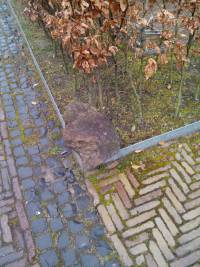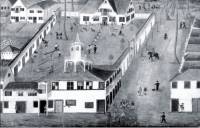Table of Contents
Leiden university and the observatory
Leiden and its university have a long and rich history that predates the observatory as an institute and as a building. On this page, you can find more information about the history of Leiden, the founding of Leiden university and the early beginnings of the observatory as an institute.
The beginning of Leiden university
The university of Leiden was founded by Willem van Oranje in 1575 with the main purpose to teach protestant theology and Dutch and to provide well-educated men to rule the government. Before, the university of Leuven, founded in 1425, was the place to go for education but it became impossible for men of the Northern provinces to study there after the Dutch revolution. It is said, that as a reward for the rebellion against the Spanish by the city of Leiden, they were granted the university which was paid for by Willem van Oranje with confiscated catholic property.[source]
When the university was founded, it had three main faculties (in order of importance: theology, law and medicin. Supporting subjects were among other things philosophy, classical languages, mathematics and the seven free arts. The following was decided: Datter voort eerste wesen zullen twee Professeurs in Theologia, twee in Jurisprudentia, een in Medicina, een in Logica, een in Physica, een in Mathematica, een Professor Latine Lingue, een Grece, een Hebraice, delwelcke nae dat het getal der studenten in elcken faculteyt vermeerderen zal, oyck vermeerdert sullen moghen worden metter tijt.1) A free translation would be: 'For the first weeks there will be two professors in theology, two in law, one in medicin, one in logic, one in physics, one in mathematics, one professor in Latin, one for Greek, one for the Hebrew language and when over time the number of students increase for each faculty there will be allowed more professors.
Mathematics and astronomy were considered part of the “septem artes liberalis”. The “seven free arts”, grammatica, dialectica/logica, retorica, artitmetica, geometria, musica and astronomica, were called free because their purpose was not to make sure the person who studied them could make money later in life. They were seen as the pure sciences. The origin of physics lies in natural philosophy which can still be seen in the degree PhD (“doctor of philosophy”). Because physics was as a rule part of medicine, many physics scientists had studied medicine and most of the time also mathematics.
The university's main focus was teaching and education as oppossed to research and the lingua franca was latin. Keep in mind that as a rule practical education and training (which we would now call “MBO” and “HBO”) was carried out on the job, controlled by guilds (“Gilden”). Starting as an apprentice and growing to the masters' level. Mechanical- and civil engineering was tought at military schools, not universities. Scientific research was mainly performed as a hobby by rich people (like Huygens and Lord Rosse), or very talented persons who sought patronage of rich people (like Tycho Brahe and Herschel).
The University was very small compared to current numbers: a few hundred to a thousand students on a total population of a few tens of thousand. Moreover, the staff was also of limited size. The consequence of this was that the academic world consisted of a relatively small circle of people.
Fun fact: The 16th century student had the extremely important privilege to tax free beer.
The beginning of the observatory
The observatory in Leiden is the oldest still operating university observatory in the world. The only observatory that is older and still operating is the one in the Vatican called the Papal observatory (1580). It was build for Clavius, a mathematician and astronomer so that he could establish what became known as the Gregorian calendar.
Although astronomy has always been part of the university as it was one of the free arts, the actual observatory was founded later, in 1633. The idea came from Jacob Golius who was the professor of mathematics at the time. He was a versatile man and did not only teach mathematics, optics and astronomy but also Arabic. In 1632 he came up with the idea to found an observatory in Leiden and he bought its first instrument, Snellius quadrant. Then he went to the board of trustees (“College van Curatoren”) and on the 14th of november 1633 they agreed to house the quadrant. This is what is considered the beginning of the observatory in Leiden.
Snellius's quadrant
Snellius's quadrant was key to the founding of the observatory but what was it meant for?
With a quadrant it was possible to determine the positions of planets and stars by measuring the angles in between them. However, Willebrord Snellius (the one from the refraction law) used his quadrant for measurements that were more down to Earth (pun intended). He used it to measure the circumference of the Earth. He did this by measuring the distance between Alkmaar and Bergen op Zoom which are at the same longitude. Then he measured the difference in the position of the Sun and by using some geometry calculated the circumference.
The quadrant can now be found in the Boerhaave museum in Leiden.
Timeline
Before the establishment of the observatory
- 1568 – 1648 Eighty year's war (minus 12 years' truce) of independence (also called the Dutch war of independence) against Philip II of Spain.
- 1574 The siege of Leiden ended.
- 1575 University of Leiden was founded.
- 1581 University housed in a confiscated Dominican nuns monastery.
- 1578 ”Blue bastion” (Blauwe bolwerk) was constructed.
- 1590 Hortus Botanicus was established.
- 1633 Leiden Observatory was established.
- 1633-1860 The observatory housed on top of the Academy building.
- 1624 Of the 45,000 citizens 10,000 die in one of the many plague epidemics. Bastions have to be used as cemeteries. The “Blauwe bolwerk” is meant for poor people.
- 1816 Burial ground on Blue bastion closed
- 1638 The observatory in Recife was established. It was modelled after the Leiden Observatory, by Georg Markgraf (1610 - 1644). This was the first European-style observatory in Southern America. Markgraf observed the Northern sky under Golius in Leiden for a year, when he joined the scientific entourage of Johan Maurits. Between 1638 en 1644 he stayed in the new Netherlands-Brazil colony. In 1640 he observed the solar eclipse there. 2)
- 1763 A private observatory in Batavia (Dutch East Indies, now Jakarta, Indonesia) was establised by Johan Maurits Mohr (1716-1775). He was a Dutch-German minister to the Dutch East India Church from 1737 on. Later he became rector of the Theological Seminar. Astronomy was his passion. With the fortune of his (third) wife he build a big private observatory with state of the art equipement, following advice of Lulofs (director of Leyden observatory). The V.O.C. was strictly focussed on trade, and had no interest in science, and thus did not give tangible support. Mohr participated in the Venus transit of June 6th 1761, June 3rd of 1769, and the transit of Mercury November 10th of 1769. The endeavours were part of the international campaign to determine the astronomical unit. The observatory went out of bussines after the earthquake of 1780. The equipment was send to Amsterdam for maintenance and subsequently lost.
- 1850 Blue bastion allotted to the Hortus Botanicus
- 1857 Blue bastion transferred to the Observatory.
- 1861 Observatory operational





